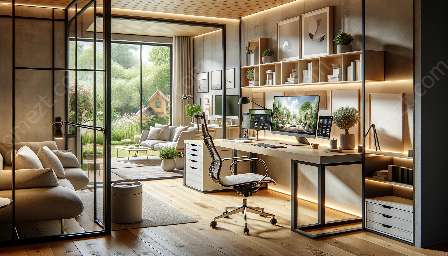Introduction to Home Office Automation Systems
With the growing trend towards remote work and the increasing reliance on technology, home office automation systems have become an essential component of modern home office design. These systems offer a seamless integration of various technologies and intelligent functionalities to create efficient, comfortable, and futuristic workspaces.
The Intersection of Home Office Design and Technology
Effective home office design is not just about aesthetics but also about integrating technology seamlessly. From smart desks and ergonomic chairs to digital whiteboards and advanced lighting systems, technology plays a crucial role in creating a productive and conducive work environment in a home office.
Key Components of Home Office Automation Systems
Home office automation systems encompass a wide range of technologies and devices that can enhance the functionality and user experience within a home office. These may include:
- Smart Lighting: Automated lighting systems that adjust based on natural light and user preferences.
- Smart Temperature Control: Systems that regulate temperature and air quality for optimal comfort and productivity.
- Voice-Activated Assistants: Integration of virtual assistants for hands-free control and management of tasks and devices.
- Automated Window Treatments: Motorized blinds or curtains that adjust based on sunlight and privacy needs.
- Smart Desks and Furniture: Adjustable and multifunctional furniture equipped with built-in charging ports and connectivity options.
- Integrated Security Systems: Surveillance cameras, smart locks, and alarms for enhanced home office security.
- Virtual Meeting Solutions: High-definition cameras and microphones for seamless virtual meetings and collaborations.
Benefits of Home Office Automation Systems
The integration of automation systems into the home office offers several benefits, such as:
- Enhanced Efficiency: Automation of repetitive tasks and seamless control of devices lead to improved productivity.
- Comfort and Convenience: Automated adjustments and personalized settings create a comfortable and stress-free work environment.
- Energy Savings: Smart energy management systems help reduce energy consumption and lower utility costs.
- Improved Work-Life Balance: Automation systems can contribute to a better balance between work and personal life by reducing administrative burdens.
- Enhanced Security: Integrated security systems provide peace of mind and protect sensitive information and assets.
The Future of Intelligent Home Design
As the concept of intelligent homes continues to evolve, the integration of home office automation systems plays a pivotal role. Intelligent home design focuses on creating interconnected, user-centric living spaces that seamlessly blend technology, sustainability, and user experience.
How to Implement Home Office Automation Systems
When incorporating automation systems into a home office, it’s crucial to consider the following factors:
- Scalability: Ensure that the systems can adapt and grow with the changing needs of the home office environment.
- Interoperability: Choose devices and technologies that can communicate and work together seamlessly through centralized control systems.
- User Experience: Prioritize ease of use and personalization to cater to individual work preferences and habits.
- Security and Privacy: Implement robust security measures to safeguard sensitive data and protect against potential cyber threats.
Conclusion
Home office automation systems are redefining the way we work from home, offering a harmonious blend of technology, design, and functionality. These systems are not only enhancing productivity but also contributing to the evolution of intelligent home design. By embracing these innovations, individuals can create futuristic, efficient, and inspiring workspaces within the comfort of their homes.


